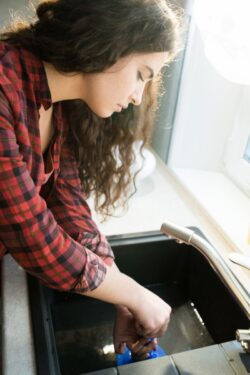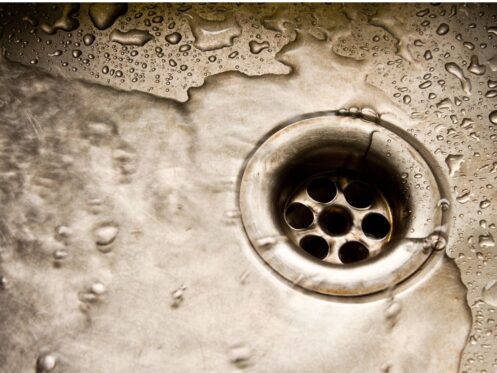Spring showers are on their way in Jerome, and while they bring fresh blooms and a sense of renewal, they also put extra stress on your home’s plumbing system. Slow drains can start as a small inconvenience, but during heavy rains, they can escalate into more serious problems like backups or clogs that disrupt your day.
This blog will walk you through the common causes of slow drains, why they shouldn’t be ignored, and what you can do to fix them. Plus, we’ll help you determine when it’s time to call a professional plumber to save you time and stress. Jerome homeowners, this one’s for you!
Common Causes of Slow Drains
Before we jump into solutions, it’s important to understand what might be causing your slow drains. Here are a few common culprits:
Hair, Soap, and Other Build-Up
Bathroom sinks, tubs, and showers are frequent victims of hair and soap residue build-up. Over time, the combination of these materials creates clogs that slow water flow through the pipes.
Pro Tip: Consider using drain covers to catch hair before it slides down the drain.
Grease and Food Particles
Kitchen drains often suffer from improper disposal of grease, oil, and food scraps. While these particles might seem harmless in small amounts, they can bind together inside the pipes, creating sticky clogs.
Reminder: Avoid pouring cooking grease down the sink. Instead, collect it in a jar and dispose of it in the trash.
Hard Water Deposits
Jerome, Idaho, is known for hard water. Hard water is water with high concentrations with dissolved minerals such as calcium and magnesium ion. Over time, hard water can lead to several issues, including scale buildup, wear and tear, and corrosion. Over time, scale buildup will reduce the inner pipe diameter and slow water flow.
Faulty Pipe Design or Damage
Pipes with incorrect slopes, narrow diameters, or damage like cracks and leaks can also cause water to drain more slowly than it should.
Why Slow Drains Are a Problem
You may be tempted to put off dealing with slow drains, thinking they’re more of an annoyance than a real issue. However, ignoring the problem will just lead to pipe damage over time. This damage comes with other problems that impact your health and safety. These problems could include:
- Standing Water that becomes a breeding ground for mold, mildew, and bacteria.
- Foul Odors caused by trapped food waste or grease that start to decay.
- Pipe Damage Over Time, especially if the clog worsens and puts extra pressure on your plumbing system.
- Flooding Risks during heavy spring rains if your pipes can’t handle increased water flow.
Catching and addressing slow drains early can save you from bigger (and more expensive) issues down the road.
How to Fix Slow Drains
If you’ve noticed any slow drains around your home, don’t panic—there are several DIY fixes you can try before calling in the pros. 
Use Boiling Water
For minor clogs in kitchen or bathroom sinks, pour a kettle of boiling water down the drain. This can break up grease or soap residue. Be careful not to use boiling water on PVC pipes, as it could cause damage.
Try Baking Soda and Vinegar
This tried-and-true method works for many basic clogs. Here’s how:
- Pour 1/2 cup of baking soda down the drain.
- Follow it with 1/2 cup of white vinegar.
- Cover the drain, wait 15 minutes, and flush with boiling water.
The chemical reaction can help dislodge light build-up in the pipes.
Use a Plunger
For bathroom sinks or tubs, a plunger can create enough pressure to help clear clogs. Make sure there is a seal around the drain to apply consistent suction.
Try a Drain Snake
For tougher clogs, a drain snake (available at hardware stores) can do wonders. It’s a long, flexible tool that you feed into the pipe to manually break up a clog.
Use Enzyme-Based Cleaners
Unlike harsh chemical drain cleaners, enzyme-based drain cleaners like Bio-One break down organic material without damaging your pipes. Just follow the instructions on the bottle and let it sit overnight.
Flush Outdoor Drains
Outdoor drains collect leaves, dirt, and other debris. Make sure to clear visible debris and flush these drains with a hose periodically to keep them flowing during spring rains.
When to Call a Plumber
While many slow drains are simple DIY fixes, there are situations where it’s best to bring in a professional plumber—especially if you’re dealing with recurring issues or more serious blockages.
Call a plumber if:
- Your Drains Remain Slow After DIY Fixes – Persistent issues might indicate a deeper clog or pipe damage.
- You Notice Water Backing Up – Water coming up in sinks or tubs is a red flag for a bigger issue, like a sewer line problem.
- Foul Smells Persist – If odors linger even after cleaning, there could be trapped debris deeper in the pipe.
- Multiple Drains Are Slow – If slow drainage is affecting multiple drains throughout your home, you could have a bigger issue with your main sewer line.
For Jerome homeowners dealing with any of these challenges, the team at Magic Electric, Plumbing, Heating + Air is ready to help.
Protect Your Home This Spring
Slow drains don’t have to disrupt your home—especially when you tackle the issue early. By understanding the causes and trying simple solutions, you can keep your plumbing ready for any spring showers Jerome might bring.
Need professional help? The qualified team at Magic Electric, Plumbing, Heating + Air is just a phone call away. Whether for a stubborn clog, foul smells, or a preventative drain inspection, we’re here to ensure your plumbing system runs smoothly.
Contact us today to schedule a service or consultation. Don’t wait until the next storm—protect your home this spring with plumbing you can count on!


